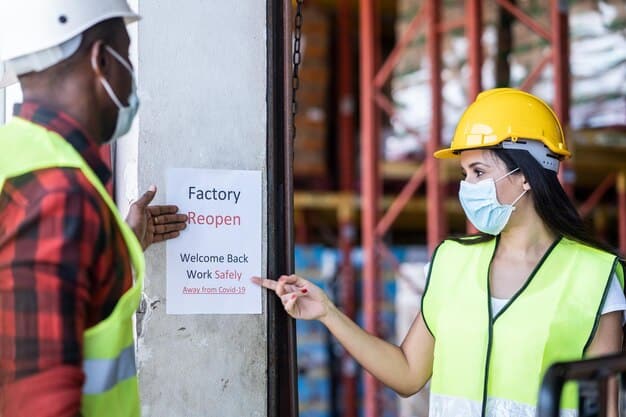Understanding New Federal Workplace Safety Regulations for Employers

Understanding the New Federal Regulations on Workplace Safety is crucial for employers to ensure compliance, protect their workforce, and avoid potential penalties, staying informed and proactive is key.
Navigating the complexities of workplace safety can be daunting, especially with the introduction of new federal regulations. Understanding the New Federal Regulations on Workplace Safety: A Guide for Employers, this guide provides a clear overview of these changes and how they impact your business.
What’s New in Federal Workplace Safety Regulations?
The landscape of workplace safety is constantly evolving, with federal regulations updated to address emerging hazards and improve worker protection. Keeping abreast of these changes is crucial for employers to maintain a safe and compliant work environment.
New federal regulations often stem from advancements in technology, increased awareness of specific workplace risks, or a need to harmonize safety standards across different industries. Understanding these changes is the first step towards implementing effective safety measures.
Key Areas of Regulatory Updates
Several key areas within workplace safety are frequently subject to regulatory updates. These encompass hazard communication, personal protective equipment (PPE), and emergency response procedures. Employers must stay informed about these distinct areas to ensure their safety programs remain effective and up-to-date.
- Hazard Communication: Regulations may be updated to include new chemicals or require more detailed safety data sheets (SDS).
- Personal Protective Equipment (PPE): Changes in PPE standards may necessitate the use of new or improved equipment to protect workers from specific hazards.
- Emergency Response Procedures: Updates to emergency response protocols may require changes to evacuation plans or training programs.
Navigating the regulatory landscape is vital for employers committed to workplace safety. Employers can ensure that they proactively address new challenges and maintain a culture of safety in their workplaces by staying informed about upcoming changes.

OSHA’s Role in Enforcing Workplace Safety
The Occupational Safety and Health Administration (OSHA) plays a pivotal role in enforcing federal workplace safety regulations. It is paramount to comprehend the role and enforcement mechanisms of OSHA when protecting your company and employees.
OSHA sets and enforces protective workplace safety and health standards. OSHA also provides information, training, and assistance to employers and workers.
Inspections and Compliance
OSHA conducts workplace inspections to ensure compliance with its standards. These inspections can be triggered by various factors, including employee complaints, accidents, or targeted enforcement initiatives. Businesses that need help with workplace safety should consider seeking compliance assistance services.
- Responding to Inspections: Knowing how to respond to an OSHA inspection is vital for employers. Prepare documentation of safety programs, training records, and hazard assessments.
- Correcting Violations: After an inspection, OSHA may issue citations for violations. Take quick action to correct the violations and avoid penalties.
- Appealing Citations: Employers have the right to appeal OSHA citations if they believe they’re unwarranted or if the abatement requirements are unreasonable.
Understanding OSHA’s role and enforcement mechanisms is essential for maintaining a safe and compliant workplace. By adhering to OSHA standards and taking proactive steps to address potential hazards, employers can safeguard their workers and avoid costly penalties. Regular safety audits are also important to ensure regulatory compliance.
Employer Responsibilities Under the New Regulations
With each update to federal workplace safety regulations, employers face the critical task of understanding and fulfilling their responsibilities. Employers must not only adhere to the letter of the law but also foster a workplace culture that prioritizes safety and well-being.
Many responsibilities include providing a safe working environment, implementing safety measures, and providing training. However, fulfilling these responsibilities, businesses can navigate regulatory changes and maintain compliance.
Implementing Safety Programs
A comprehensive safety program is at the core of every employer’s responsibility. This should involve proactive measures to identify and mitigate potential hazards, ensuring employee awareness through clear communication and training.
Regularly conducting risk assessments to identify potential hazards and implementing appropriate control measures is an example of the responsibility that falls on the employer. Additionally, developing and enforcing safety policies and procedures can help employers fulfill their responsibilities under the updated regulations.
Providing Adequate Training
Training is essential for ensuring that employees understand the potential hazards in their workplace and how to protect themselves. Employers should provide regular training sessions and document all training activities.
- Types of Training: Employers must provide training on hazard recognition, safe work practices, and the use of personal protective equipment (PPE).
- Documentation: Maintaining detailed training records is essential for demonstrating compliance with OSHA requirements.
- Frequency: Training should be provided regularly to ensure that employees stay up-to-date on the latest safety procedures.
Employers’ responsibilities under federal workplace safety regulations are extensive but crucial for protecting workers and maintaining compliance. Taking the initiative now to implement safety programs is essential to complying with the new legislation.

How to Conduct a Workplace Safety Audit
Regular workplace safety audits are vital for employers to identify potential hazards and ensure compliance with federal regulations. A well-executed audit can reveal weaknesses in safety programs and foster a safer working environment.
The audit will include assessing compliance and working to improve safety. By executing regular audits, companies enhance their safety standards and proactively mitigate risks which make the workplace safer.
Steps to Conducting an Effective Audit
Effective workplace safety audits encompass preparation, thorough inspection, and follow-up actions. Conducting these steps ensures accuracy in the evaluation and prompt resolution of any issues that arise during the audit.
- Preparation: Plan the audit scope, gather relevant documents, and notify employees.
- Inspection: Conduct a physical inspection of the workplace to identify hazards and assess compliance with safety standards.
- Follow-Up: Develop a corrective action plan to address identified hazards and track progress on implementation.
Performing a safety audit is a robust way to help protect your company and employees. Using these steps and conducting regular safety audits, employers can proactively identify and address potential hazards, reduce the risk of accidents and injuries, and demonstrate a commitment to workplace safety.
Penalties for Non-Compliance
Failure to comply with federal workplace safety regulations can result in significant penalties for employers. Understanding the types of penalties and the potential costs of non-compliance is crucial for prioritizing workplace safety.
The impacts of non-compliance include financial strain, legal ramifications, and reputational damage. Therefore, for a company to show a dedication to workplace safety, proactive compliance is essential.
Types of Penalties
OSHA can issue various penalties for non-compliance. The penalties include fines, citations, and even criminal charges in certain cases. Each of these penalties bring significant implications for employers.
Fines for serious violations can be substantial, and repeat or willful violations can result in even higher penalties. Citations can also lead to increased scrutiny from OSHA and potential legal action. In extreme cases, employers may face criminal charges for egregious safety violations that result in worker injuries or fatalities.
Cost of Non-Compliance
The cost of non-compliance extends beyond financial penalties. Accidents and injuries can lead to increased workers’ compensation premiums, lost productivity, and damage to the company’s reputation.
Moreover, non-compliance can erode employee morale and trust, leading to decreased productivity and higher turnover rates. Therefore, preventing safety violations proactively is a financially prudent choice for businesses.
Resources for Staying Updated and Compliant
Staying updated on federal workplace safety regulations and maintaining compliance can be challenging. However, various resources available to employers can help them stay informed and implement effective safety programs.
These resources include government agencies, industry associations, and professional consultants. Proactively utilizing all the resources can help companies comply with workplace safety standards effectively.
Government Agencies and Resources
OSHA provides a wealth of information and resources for employers. The information and resources include training materials, online tools, and compliance assistance programs. Regular monitoring of OSHA’s website ensures companies stay informed on current guidelines.
Additionally, state-level agencies often provide resources and support for workplace safety initiatives. Collaborating with state agencies can enhance compliance efforts and customize safety programs to suit the specific needs of your business.
Industry Associations and Professional Consultants
Industry associations often offer specific resources and standards for their members. Furthermore, professional consultants can assist businesses in navigating the complexities of compliance and ensuring adherence to OSHA standards.
- Industry-Specific Standards: Industry associations develop and promote best practices for workplace safety.
- Consulting Services: Professional consultants offer expertise in conducting safety audits, developing safety programs, and providing training.
Staying compliant with federal workplace safety standards is essential for the well-being of any company. Leveraging the provided resources guarantees a safe environment that protects both people and profitability.
| Key Aspect | Brief Description |
|---|---|
| 🛡️ Compliance | Adhering to new federal safety regulations is crucial for avoiding penalties. |
| ⚠️ Hazard Communication | Ensure proper SDS and labeling for all hazardous materials in the workplace. |
| 🛠️ Safety Programs | Implement comprehensive safety programs and conduct regular risk assessments. |
| 📚 Training | Provide adequate training to all employees on safety procedures and equipment use. |
Frequently Asked Questions
▼
The main objective is to enhance worker protection by updating standards to address emerging hazards and ensure safer work environments. They aim to reduce workplace accidents and illnesses.
▼
Workplace safety audits should generally be conducted at least annually, or more frequently if significant changes occur in the workplace, such as new equipment or processes.
▼
Training must cover hazard recognition, safe work practices, and the proper use of personal protective equipment (PPE). Specific training requirements vary depending on the industry and potential hazards.
▼
Resources include OSHA’s website, state-level agencies, industry associations, and professional safety consultants. These offer training materials, compliance assistance, and expert consulting services.
▼
Non-compliance can lead to fines, citations, increased workers’ compensation costs, legal action, and damage to the company’s reputation. In severe cases, employers may face criminal charges.
Conclusion
In conclusion, understanding the new federal regulations on workplace safety is crucial for employers to ensure compliance, protect their workforce, and avoid potential penalties. By staying informed, implementing effective safety programs, and providing adequate training, employers can create a safer and healthier work environment for all.





